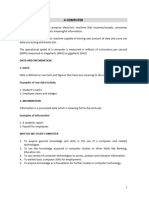Computer Basic and Classification
Uploaded by
madhusivaComputer Basic and Classification
Uploaded by
madhusiva1.
2 EVOLUTION OF COMPUTERS (or) HISTORY OF COMPUTERS The need for a device to do calculations along with the growth in commerce and other human activities explain the evolution of computers. 1.2.1 Sand Tables In ancient times, people used fingers to perform the calculations such as addition and subtraction. Even today, simple calculations are done on fingers. Soon, mankind realized that it would be easier to do calculations with pebbles as compared to fingers. Consequently, pebbles were used to represent numbers, which led to the development of sand tables (see Figure 1.2). They are known to be the earliest device for computation. A sand table consists of three grooves in the sand with a maximum of 10 pebbles in each groove. To increase the count by one, a pebble has to be added in the right-hand groove. When 10 pebbles were collected in the right groove, they were removed and one pebble was added to the adjacent left groove. Afterwards, sand tables were modified extensively and these modifications resulted in a device known as Abacus.
Figure 1.2. A Sand Table Showing 125 (Ref: Computer fundamentals and programming in c by Anitha Goel & Ajay Mittal) 1.2.2 Abacus
You might also like
- Class 9 Computer Book Federal Board Merged50% (4)Class 9 Computer Book Federal Board Merged120 pages
- Chapter 1 Class 9 Computer Book Federal Board100% (4)Chapter 1 Class 9 Computer Book Federal Board29 pages
- Historical Development of Computers - ClassNotes - NG %No ratings yetHistorical Development of Computers - ClassNotes - NG %8 pages
- PROGRAMMING-FLOWCHART-PSEUDOCODE-ALGORITHMNo ratings yetPROGRAMMING-FLOWCHART-PSEUDOCODE-ALGORITHM40 pages
- A Brief Timeline in The History of ComputersNo ratings yetA Brief Timeline in The History of Computers6 pages
- COS101 Introduction To Computing SciencesNo ratings yetCOS101 Introduction To Computing Sciences65 pages
- PROGRAMMING-FLOWCHART-PSEUDOCODE-ALGORITHMNo ratings yetPROGRAMMING-FLOWCHART-PSEUDOCODE-ALGORITHM41 pages
- Historical Development of Computers FSC 113No ratings yetHistorical Development of Computers FSC 11315 pages
- CSC 111 - Introduction To Computer Science - Corrected VersionNo ratings yetCSC 111 - Introduction To Computer Science - Corrected Version93 pages
- Unit 1 Computer Their Origin and Applications: Structure Page NoNo ratings yetUnit 1 Computer Their Origin and Applications: Structure Page No22 pages
- Unit 1 Computer Their Origin and Applications: Structure Page NoNo ratings yetUnit 1 Computer Their Origin and Applications: Structure Page No22 pages
- Index Unit - 1 Content Page No H C Generation OF Computers Types of ComputersNo ratings yetIndex Unit - 1 Content Page No H C Generation OF Computers Types of Computers46 pages
- Introduction To Computers 1.1 History of ComputersNo ratings yetIntroduction To Computers 1.1 History of Computers132 pages
- Reviewer-in-Computer-1-1st-Quarter-Examination (1)No ratings yetReviewer-in-Computer-1-1st-Quarter-Examination (1)16 pages
- Anna Univeristy 1st Sem Syllabus For Marine EngineeringNo ratings yetAnna Univeristy 1st Sem Syllabus For Marine Engineering23 pages


































































